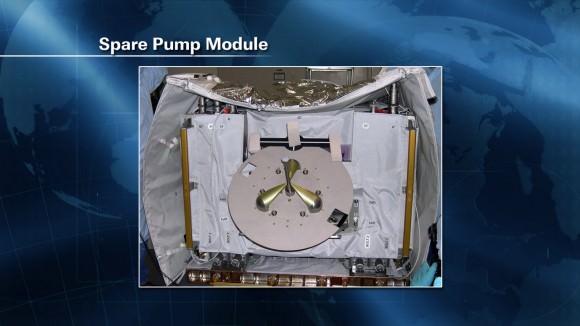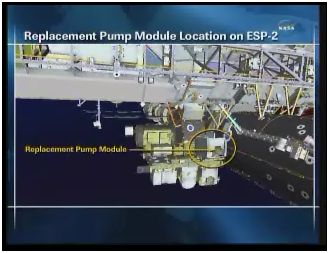[/caption]
*Updated at 11 pm CDT — dates have changed for EVAs.
Two spacewalks will be required to remove and replace a pump on a critical cooling system on the International Space Station, and NASA is hoping to have station astronauts and ground teams ready by Thursday, August 5 Friday, August 6 for the first EVA. The pump module failed over the weekend, prompting a shift to a backup system, while other systems were shut down as a precaution. The backup system is working perfectly, and having a second system failure is highly unlikely, but NASA does not like to operate on a “single-string” system without redundancy. “Having another failure would be a serious situation for the program that we want to avoid,” said ISS program manager Mike Suffredini.
Update:
NASA had originally scheduled the first EVA for Thursday, August 5 and the second for Sunday, but decided late Monday that they needed more time for both astronauts and ground crews to prepare. Now, the first spacewalk will be Friday morning, starting at 6:55 a.m. EDT, (1155 GMT) with the second EVA on Monday, August 9.
An EVA was already scheduled for August 5 for astronauts Doug Wheelock and Tracy Caldwell Dyson to install part of a robotic crane and to prepare for a new module due to arrive in November aboard space shuttle Discovery. But that work will be postponed in order for the astronauts to do the priority fix.
“Typically, we allow two weeks to prepare for this type of EVA, but we decided to take advantage of having an EVA already scheduled, so this is a very aggressive approach,” said Flight Director Courtenay McMillan, who is leading the team supporting the spacewalk.
This type of EVA is part of what is called the “Big 14” set of contingency spacewalks that all ISS astronauts train for in the event of system failures like the one that happened on Saturday.
Suffredini said he is confident everyone can be ready. “The crew is in great spirits and are ready to do this,” he said. “These Big 14 EVA’s cover major systems repairs that an increment crew might have to do without the shuttle there. They train for both specific and generic spacewalks, and this particular one they have trained for. So they have some familiarity with the tasks they will be asked to do.”
Additionally all the operations teams have been working around the clock to prepare for the fix. “The ops team is full up for support,” Suffredini said. “If you were to go in the control room, it looks more like a shuttle flight is going on right now. We do train for these kinds of anomalies, and have been fortunate that we haven’t had to deal with anything like this before, but we have good plans in place.”

The pump — which was installed in October 2002 — failed Saturday night after a spike in electrical current tripped a circuit breaker. When the 350 kg (780-pound) pump failed, it shut down half of the station’s cooling system. Efforts to restart the pump, which feeds ammonia coolant into the cooling loops to maintain the proper temperature for the station’s electrical systems and avionics, were not successful. Suffredini said data suggests the motor is not frozen, as it did begin to pump when they did the restart, so that tells them there is likely a short in the electrical system.
The station’s crew worked with Mission Control to put the station in a stable configuration. The crew, which is in no danger, has resumed normal work activities and most of the systems are up and running. One freezer was shut down, but frozen specimens which are to be returned to Earth were transferred to another freezer.
McMillan said astronauts Cady Coleman and Sunny Williams are working today in the Neutral Buoyancy Lab — the big pool where astronauts train for EVAs — doing development runs for the emergency EVAs.
“They are doing the tasks that they forsee we’ll need to do, trying to work out details of the timeline,” she said. “And depending on how things go today we’ll see if we’ll be ready for the EVA.”
There are spare pump modules already on board the station, and Suffredini said that if more modules are needed, they can fit on board the Japanese HTV resupply vehicles or SpaceX’s cargo vehicle, and don’t need to be brought up by the space shuttle.


That’s not the AE-35 unit, is it? 🙂
“they can fit on board the Japanese HTV resupply vehicles or SpaceX’s cargo vehicle”
Yup. Or they can just give them to Santa Claus to bring the pumps up there (it’s just as realistic).
They discuss about two vehicles that have not reached yet the ISS (they didn’t even reach yet the space). I don’t say these two vehicles won’t work eventually (and I hope they will), but until they have a succesfull flight, I think it is too early to rely the ISS redundancy on some nonexistent acomplishments.
@Quasy in your rush to prejudge SpaceX; or perhaps extend Shuttle… you seem to have forgotten that the HTV *did* reach the ISS and what’s more was allowed to make a delivery on its first attempt. Unlike SpaceX which will have to jump through several orbital hoops first. Unnecessary orbital hoops IMHO.
Here’s a pretty picture:
http://www.nasa.gov/mission_pages/station/multimedia/htv_arrival.html
But that aside my main purpose for commenting is a BIG “thank you” to Nancy for the GMT equivalent. Always appreciated by those of us who follow the ups and downs of the ISS from distant lands.
And of course both Suffredini and Quasy forgets that ESA is contracted to lift 4 more ATVs before 2015 (and 7 total to 2020 is estimated).
Ditto on the Nancy thanks. At least UT appreciates other nations, if not NASA does. (*sniff*)
You got me all wrong. As I said in my post I hope SpaceX will succeed with the Dragon, but it is one thing to support them and another one to have just wishful thinking and to make plans on that. I do not support the extension of the Shuttle. In my opinion the Shuttle is an awsome design but for a different budget. With the right money, a next generation Shuttle would have been great (one to include the lessons learned from the curent Shuttles). But for the moment it’s like you have money for a small family car, you struggle and buy a van, but then you don’t have money to maintain the higher costs of the van (although it’s nice to have it and to go for a short ride once in a while).
Regarding the HTV, mea culpa. I was not sure if it has reached the ISS yet, but I did not remember any ISS docking.
As for the ATV, I know that it can pick a spare pump easily for delivery to the ISS (and I am sure it can be delivered also with a Progress resuply) but these two were not mentioned in the original article (btw: the grey text at the end of the article is a quote?)
@QUASY – “…(and I am sure it can be delivered also with a Progress resuply)…” Ummm… no way. The pump unit is far too big to fit thru the hatch in Progress.
Here’s the link I posted in the Aug. 1st story: “Space Station Cooling System Shuts Down”
http://microgravity.grc.nasa.gov/SpaceOps/ISS/Cooling/
Ooops, that link does not include dimensions…
The PM’s (Pump Modules) are 69″ X 50″ X 36″… a full description can be found at: http://www.boeing.com/defense-space/space/spacestation/systems/docs/ISS%20Active%20Thermal%20Control%20System.pdf
I was also looking for that those dimensions (just for curiosity to check if the pump can be delivered with the progress 🙂
The small diagonal for the pump modules (with the above mentioned dimensions) would be ~61″ – that is ~1.5m). I could not find exactly the diameter of the front hatch of the Progress; I could only find that the inner diameter of the collar has 1.3m (for Soyuz; but I exepect it to be very similar with progress). So you’re right, they can’t squeeze the pump modules in the Progress ship even if they try really hard 🙂
Now this seems odd to me: the russians had the Mir for such a long time, but they did not develop a larger resuply ship or a resupply ship with an unpressurised area with storage on the “outside” (as far as I know; I may be wrong)
Quasy, I don’t think I get you at all.
None of the other possibilities of resupply (and eventual repair through Dragon or a future ATV descent modification, being mentioned by ESA planners at least once) affect the Shuttle or its prolonging. It would be different if resupply wouldn’t work, say for new solar panels.
The way I see it is that the shuttle is (soon) a closed chapter, and now we have a new situation with its own possibilities. “If only” doesn’t make repairs.
Wikipedia claims a lot of studies including crewed versions or mini-stations. ATV evolution lives on:
“In November 2008, ESA ministers budgeted for a feasibility study into developing a re-entry capsule for the ATV, a requirement for developing either a cargo return capacity or a manned version of the ATV.[33] ESA signed a €21 million study contract with EADS Astrium on 7 July 2009[34][35].”
TL: I know that the other possibilities of resupply don’t affect the Shuttle. I was just mentioning the Shuttle as Brobof suggested that I am supporting its extension (which I am not).
What I tried to highlight in my post is that the article mentions that in future such problems can be solved with Dragon and HTV (two vehicles that didn’t dock yet with the ISS). Yet they say nothing about the other options that are more likely: ATV + the last Shuttle next year (as mentioned above, Progress is not an option for bulky components as it has a small docking port).
But now I don’t understand what ATV evolution has to do with this topic. If you are referring to repairs: it’s cheaper to send a new component “up” and to dump on orbit the broken one, rather than bring back to earth for repair the broken one and then to send it back up).
I’m still not getting it.
– First you discuss two vehicles that is or will be used to ISS. HTV was docked with ISS for 30 days. (Wikipedia.) And Brobof already mentioned it.
And there are more vehicles, again already used with ISS.
– Then you seemed to defend the Shuttle when prompted by Brobof.
So it is not clear to me what you meant to say and are still saying. However, if you are clear on what you meant to say, that is at least something. I’m sorry if I’m dense.
It has to do with all possibilities of repair. It is also one of the motivations behind ESA’s development of the ATV.
Update from NASA today 08.05.10 says that the spacewalks will be further delayed until early next week – putting those two spacewalks closer to the time(s) of the Perseid Meteor shower. Regardless, its probably better to let the recent coronal mass ejection activity subside any way? NOT a good time for a spacewalk? Or, not the BEST?